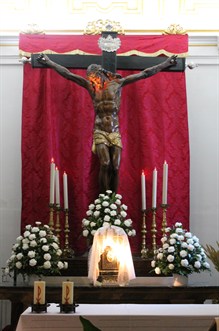The Ermita del Cristo de los Doctrinos
In 1543 a disciple of Ignatius of Loyola, Francisco Villanueva, came to study at the University of Alcalá. During his tenure, Villanueva wanted to design what would be the first college of the Society of Jesus, founded in Spain, and for such an endeavour he could count on the help of major benefactors who had met Ignatius of Loyola in the years he spent in Alcalá, such as Doña Beatriz Ramírez, Doña Mencia de Benavente and, above all, Doña Leonor de MascareñasDoña Leonor de Mascareñas (1503-1584) was a lady of the court of Madrid, who came to be legal guardian (aya) of Prince Philip, the future Philip II and Prince Don Carlos, as well as being camarera mayor of Queen María de Austria. She met Santa Teresa de Jesús, sharing with her the mystical spirituality of her Carmelite reform: which drove her to found numerous monasteries close to the court. She was also a benefactress of several Jesuit colleges., guardian (aya) of the future King Philip II. In 1546 they rented a courtyard which is the current courtyard of the ermita (church, chapel) of the Cristo de los Doctrinos (Christ of the instructed), known then and now as the Corral de Mataperros (courtyard of the urchins). That corral (courtyard) served to provide accommodations to poor students of the University, even though it had already been abandoned as Villanueva and his brethren came to live there. Thus the Jesuit college was born, even though the fathers only lived there for two years due to the insalubriousness of the area. The same place, which, for a short time, was the seat of the Company, is today the Ermita del Cristo de los Doctrinos, which presents significant vestiges of Jesuit Baroque. From 1575 was there the Seminario de Niños de la Doctrina, where orphaned children were educated and where, 1661, the Cofradía (brotherhood) of Cristo de los Doctrinos was created, one of the oldest of Alcalá.
 In the Plaza de los Doctrinos, in addition to the Ermita de los Doctrinos, the façade of the temple and monastery of the Carmelites of Corpus Christi (seventeenth century), there is a modern statue of Ignatius of Loyola, which recalls the location in the square of the Jesuit college. The exterior of the Ermita is in the typical style of the Barocco madrileño (photo). After crossing a small lobby, there are three places: the corral de Mataperros, the origin of the ancient Jesuit colégio of Alcalá; the sanctuary, which we will focus on shortly and the sacristy, which has been turned into a museum which houses sacred Baroque works from various churches of the city.
In the Plaza de los Doctrinos, in addition to the Ermita de los Doctrinos, the façade of the temple and monastery of the Carmelites of Corpus Christi (seventeenth century), there is a modern statue of Ignatius of Loyola, which recalls the location in the square of the Jesuit college. The exterior of the Ermita is in the typical style of the Barocco madrileño (photo). After crossing a small lobby, there are three places: the corral de Mataperros, the origin of the ancient Jesuit colégio of Alcalá; the sanctuary, which we will focus on shortly and the sacristy, which has been turned into a museum which houses sacred Baroque works from various churches of the city.
 The interior of the Ermita de los Doctrinos, in Baroque style and consisting of a nave, was restored in 1702. The altar houses the famous Cristo de los Doctrinos (picture), created by the jesuit sculptor Domingo Beltrán between 1587 and 1590, the year of his death in Alcalá. The example of Christ crucified was made by Beltrán for the high altar of the church of the Colegio Máximo of the Society of Jesus (the current parish church of Santa María in the calle de libreros), but after the closure of numerous churches and monasteries in the late eighteenth century, it was transferred to the Ermita de los Doctrinos. It is, without doubt, the best wood carving which is preserved in Alcalá. To accomplish it, Beltrán used American satin-like wood, and the very absence of polychrome highlights the elegance and colour of carved wood, which became darker with the passage of time. Ebony was used for the crown of thorns and the hair of Christ. This sculpture mixes the Classicism that the artist learned from Italian craftsmanship with a glimmer of Mannerism from the end of the sixteenth century.
The interior of the Ermita de los Doctrinos, in Baroque style and consisting of a nave, was restored in 1702. The altar houses the famous Cristo de los Doctrinos (picture), created by the jesuit sculptor Domingo Beltrán between 1587 and 1590, the year of his death in Alcalá. The example of Christ crucified was made by Beltrán for the high altar of the church of the Colegio Máximo of the Society of Jesus (the current parish church of Santa María in the calle de libreros), but after the closure of numerous churches and monasteries in the late eighteenth century, it was transferred to the Ermita de los Doctrinos. It is, without doubt, the best wood carving which is preserved in Alcalá. To accomplish it, Beltrán used American satin-like wood, and the very absence of polychrome highlights the elegance and colour of carved wood, which became darker with the passage of time. Ebony was used for the crown of thorns and the hair of Christ. This sculpture mixes the Classicism that the artist learned from Italian craftsmanship with a glimmer of Mannerism from the end of the sixteenth century.
